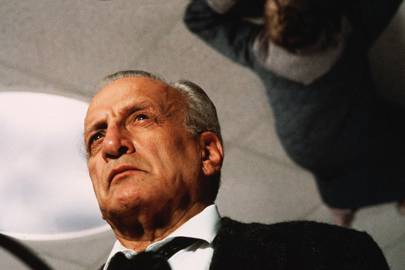

The real drama here is interior, and symbolic. Though the narrative is fairly straightforward (nothing like the wildly disjoined Malick film Knight Of Cups), its meant to be watched less as filmed drama than to be read like an icon that moves. This film is a parable about the meaning of suffering. But that’s not so, because already, says one character, the Nazis are killing and imprisoning priests. Later, we hear it said - maybe by Franz, I can’t remember - that the Catholic leadership is hoping that their silence will keep the Nazis off their back. On the way out, Franz concludes that the bishop is scared. He goes to the bishop for advice, but the bishop tells Franz that “the Church” tells him he has a duty to the Fatherland. Franz goes to his parish priest for support, but the priest tells him he would be better off not bringing trouble onto his home, where he lives with his wife, his three little girls, and his widowed mother. For this Catholic peasant, this is primarily a matter of not cooperating with evil. Though he believes the war is unjust, Franz is not a pacifist. To him, that would be bowing down before a false idol. Before you know it, though, the locals are inebriated by Nazism and race hatred.įranz concludes that he cannot do as all German soldiers must, and swear a loyalty oath to Hitler. The sound of a plane flying overhead in Saint Radegund signals that the serpent has invaded the garden. The idea is that he descends from the skies like a god come to earth. The opening scene of the Riefenstahl film is a shot taken from the plane bearing the Hitler to the 1934 Nazi Party Congress in Nuremberg. When this movie opens, Hitler and Hitlerism seem so very far away from the picture-postcard mountain village. Malick opens his film with footage from Leni Riefenstahl’s terrifying Nazi propaganda film Triumph Of The Will, which portrays Hitler as a god of a new pagan Germanic religion. It’s no doubt the case that the people of Saint Radegund, the tiny Alpine village where Franz and his wife Fani work their farm, all would have counted themselves followers of Christ. As a Slovak priest said, “In those days, the Gospel shone like a light in the darkness. That movie line brought to mind the words I heard over and over in my travels through the Soviet bloc last year, for my next book: that the one thing that was better about the Communist times was that the line between good and evil was easier to perceive. That seems to me to be Malick’s commentary on his own time. The old artist also says that an even darker day is coming when men won’t even fight against the truth - they’ll just ignore it. We don’t want to be reminded of it.”Ī Hidden Life points to Christians, and forces us to ask: Am I an admirer of Christ, or a follower? There is a moment in the film when Franz stops by the village church and falls into conversation with an older man who is painting frescoes and other images of Bible stories on the church walls. I would say to Christians who think they know all about Christianity: see this movie. It is a perfect example of what Cardinal Ratzinger meant when he said that the greatest arguments for the Christian faith are the art that comes out of it, and the saints. I would say to people who have decided that they know all they need to know about Christianity, and have rejected it: see this movie.

All of them are great films, and great Christian films, but this one is in a class of its own. Nothing else even comes close - not The Passion Of The Christ, nor The Gospel According To St. It’s without question a masterpiece, one of the greatest films I’ve ever seen, and to my mind, the best evocation of the Gospel ever committed to film. I am hesitant to write about it now, because the movie is overwhelming. The film finally arrived within driving distance of me in Baton Rouge, and fearing that it wouldn’t be here long, I drove with a couple of Christian friends to watch it this afternoon. I went this afternoon to New Orleans to see Terrence Malick’s new film A Hidden Life, about the struggle of Austrian peasant farmer Franz Jägerstätter, a Catholic imprisoned and executed by the Nazis because he refused to swear a loyalty oath to Hitler.


 0 kommentar(er)
0 kommentar(er)
